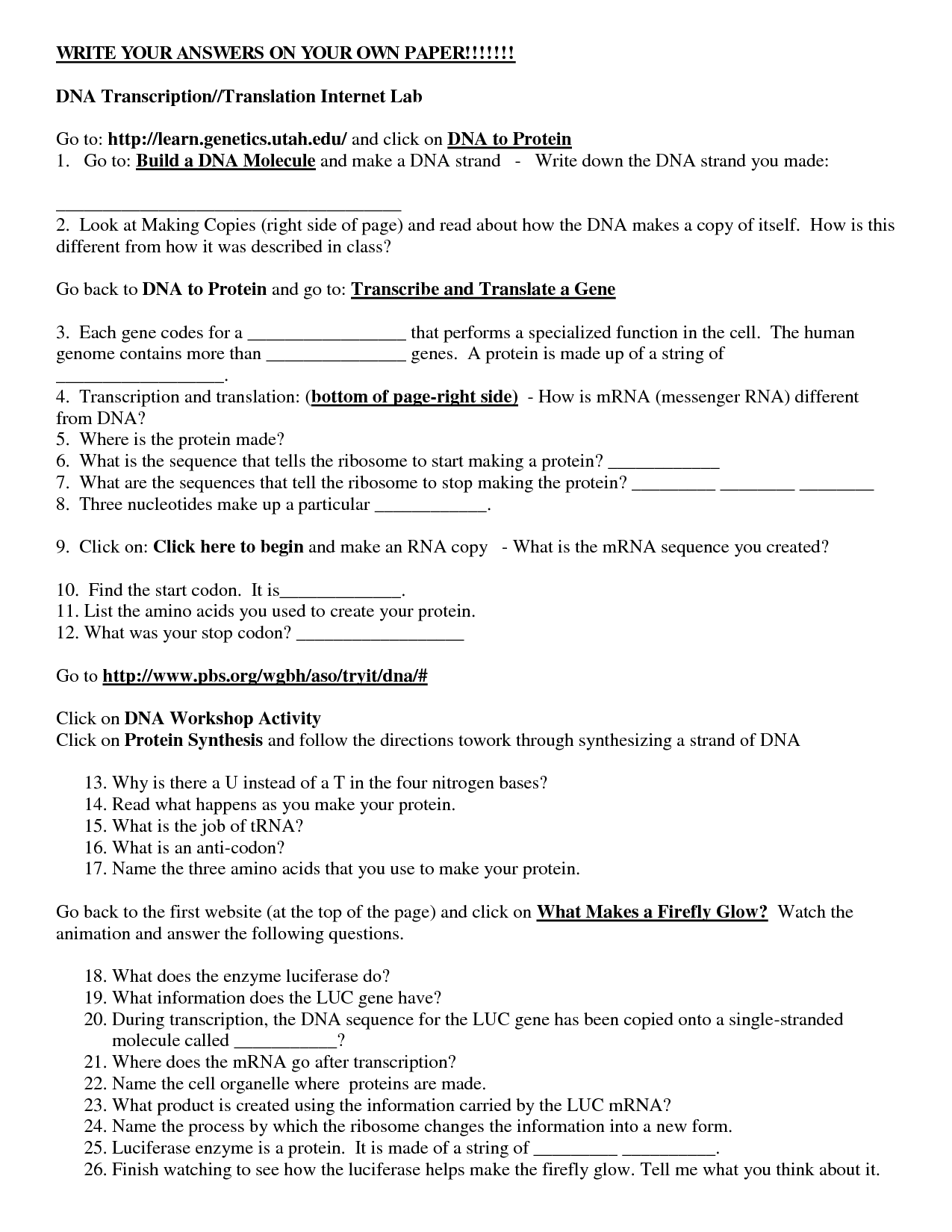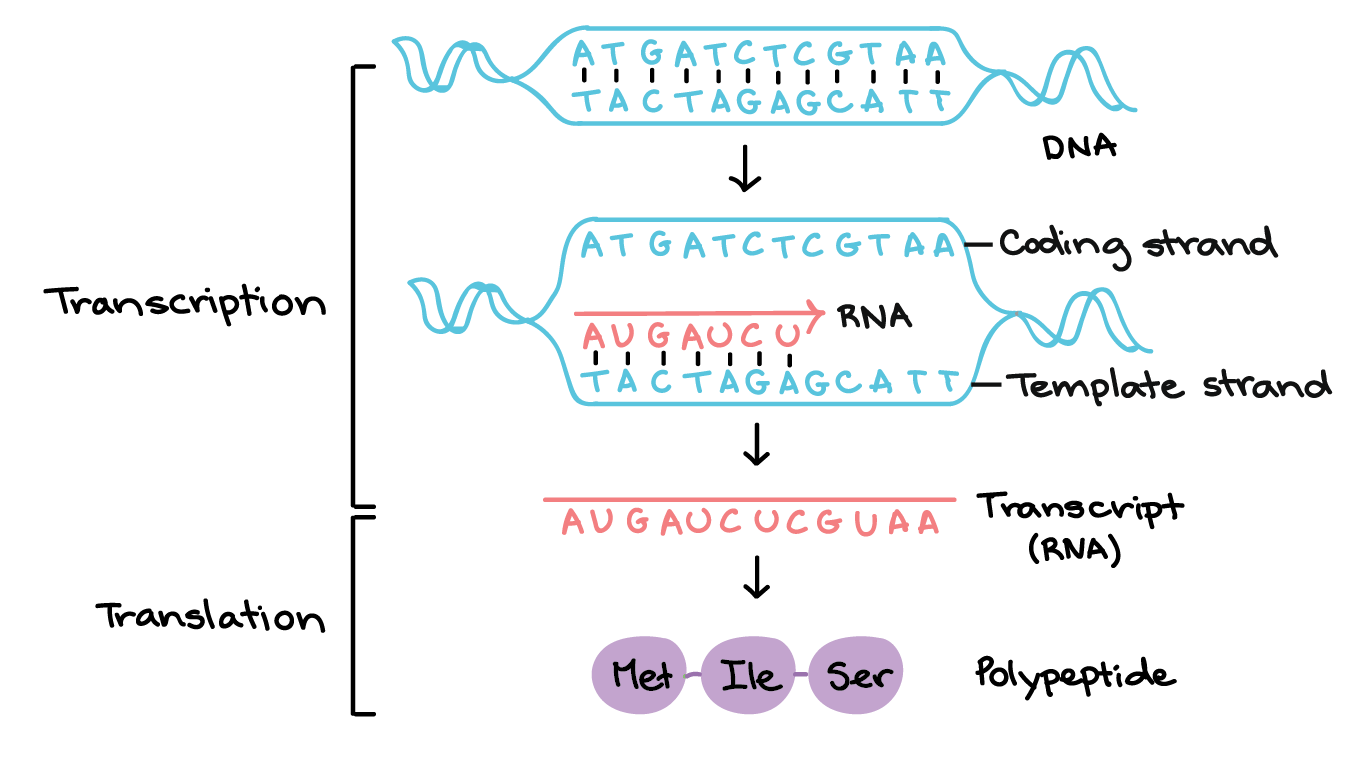Imagine a world without proteins. No muscles to move, no enzymes to digest your food, no antibodies to fight off infections. That’s the reality if our cells couldn’t create these essential molecules. But how does this amazing feat of life happen? Enter the fascinating world of protein synthesis, a journey that involves two key processes: transcription and translation. If you’ve ever wondered how a simple DNA code gets translated into the complex machinery of life, then this comprehensive guide is for you!

Image: www.worksheeto.com
This article will demystify the intricate dance of DNA, RNA, and amino acids, offering a clear and engaging explanation of these fundamental processes. We’ll delve deep into transcription and translation, uncovering the secrets of how our genes create the proteins that define our very existence. So, buckle up, as we embark on an exciting exploration of the molecular machinery that makes life possible.
The Central Dogma: A Blueprint for Life
At the heart of protein synthesis lies the central dogma of molecular biology – the fundamental principle governing how genetic information flows within a cell. This dogma describes the unidirectional flow of information from DNA (deoxyribonucleic acid) to RNA (ribonucleic acid) to protein. Imagine DNA as the master blueprint, containing all the instructions for building and maintaining a cell. But DNA can’t directly create proteins – it needs an intermediary, RNA.
Think of the DNA blueprint as residing in a secure vault. To access the instructions, RNA acts as a messenger, copying the DNA sequence and bringing it to the protein synthesis machinery. This process of copying DNA into RNA is called transcription. But the story doesn’t end there. RNA, in turn, directs the production of proteins through a complex process called translation.
Transcription: Unlocking the DNA Code
Picture a busy office with a team of copy editors. They’re tasked with meticulously recreating a vital document, ensuring every letter and punctuation mark is perfectly replicated. In the cell, transcription is like that copying process. It involves the creation of a messenger RNA (mRNA) molecule from a DNA template.
But how does this happen? It’s like a puzzle where matching pieces come together. First, an enzyme called RNA polymerase binds to a specific region on the DNA molecule called the promoter. This region acts like a “start” signal, indicating where transcription should begin. Then, RNA polymerase unwinds the DNA double helix, much like unzipping a zipper, exposing the DNA nucleotides (the building blocks of DNA).
Next, using the DNA as a template, RNA polymerase starts assembling a new RNA molecule. It does this by reading the DNA sequence and pairing complementary bases: adenine (A) with uracil (U), guanine (G) with cytosine (C). The result is a single-stranded mRNA molecule that carries the genetic instructions for protein synthesis.
Translation: Building the Proteins
Think of the mRNA molecule as a blueprint for building a complex machine – the protein. This blueprint needs to be interpreted and translated into the correct sequence of amino acids, the fundamental building blocks of proteins. This is where translation comes into play.
Translation takes place on ribosomes, tiny cellular machines that act like construction workers. These ribosomes bind to the mRNA molecule and start reading its sequence of codons. Codons are three-nucleotide sequences that code for specific amino acids.
Each codon is like a code word, telling the ribosome which amino acid to bring next. Using their special “delivery trucks,” aptly named transfer RNA (tRNA) molecules, ribosomes collect the correct amino acids and link them together in the order specified by the mRNA message. The process continues, codon by codon, until the ribosome reaches a “stop” signal, indicating the end of the protein sequence.

Image: www.javatpoint.com
The Importance of Accuracy: Ensuring Protein Perfection
The beauty of this complex process lies in its extraordinary accuracy. Every step, from transcription to translation, must happen flawlessly to ensure the final protein is correctly synthesized. If even a single base is changed in the DNA sequence, it can lead to a change in the amino acid sequence, potentially altering the protein’s function.
This is where nature’s proofreading mechanisms come into play. RNA polymerase and ribosomes have built-in error detection and correction mechanisms to minimize mistakes. And even if a few errors slip through, the cell has backup systems to ensure the protein is properly folded and functional.
Protein Synthesis: The Foundation of Life
The intricate dance of transcription and translation is not just a textbook concept – it’s the foundation of life itself. Without this molecular machinery, our cells couldn’t produce the proteins essential for all aspects of living:
- Enzymes: Facilitating chemical reactions in the body, like digestion and energy production
- Antibodies: Protecting us from diseases by recognizing and attacking foreign pathogens
- Hormones: Acting as messengers, regulating many bodily functions
- Structural components: Building the structures of our cells, tissues, and organs
Proteins are the workhorses of the cell, carrying out a multitude of functions that keep our bodies alive and thriving.
Beyond the Basics: A Deeper Dive into Protein Synthesis
The world of protein synthesis is vast and complex, with ongoing research revealing new insights into its intricate mechanisms. Here are some exciting areas of exploration:
The Regulation of Protein Synthesis:
Understanding how the cell controls the production of specific proteins is vital for comprehending cellular function. The regulation of gene expression involves complex networks of proteins and RNA molecules that can turn genes on and off in response to internal and external cues.
The Role of Non-Coding RNA:
For many years, scientists thought that only DNA and protein-coding RNAs played a role in cellular function. However, recent discoveries reveal that non-coding RNAs (ncRNAs), which do not code for proteins, are crucial in regulating gene expression. Some ncRNAs directly interact with DNA or with protein-coding RNAs, influencing their activity.
Protein Folding: A Dance of Complexity:
Once a protein is synthesized, it needs to fold into a specific three-dimensional structure to function correctly. This folding process is complex and often involves chaperone proteins that guide the newly synthesized protein to its correct shape.
Protein Synthesis Transcription And Translation Answer Key
Answer Key: A Guide to Protein Synthesis
Here is an answer key to help you test your understanding of the concepts discussed:
-
What are the two main processes involved in protein synthesis?
- Transcription and translation
-
What is the role of RNA polymerase in transcription?
- RNA polymerase is an enzyme that reads the DNA sequence and uses it as a template to build an mRNA molecule.
-
What is a codon?
- A codon is a three-nucleotide sequence on mRNA that codes for a specific amino acid.
-
What is the role of ribosomes in translation?
- Ribosomes are like tiny factories, reading the mRNA sequence and using tRNA molecules to bring the correct amino acids to build a protein.
-
Why is accurate protein synthesis essential for cellular function?
- Even a small error in protein synthesis can alter the protein’s function, leading to disease or malfunction.
-
Give an example of a protein and its function.
- Insulin, a protein hormone, regulates blood sugar levels.
Remember, this is just a starting point! The fascinating world of protein synthesis continues to unfold, with exciting discoveries being made all the time. Stay curious and keep exploring!






